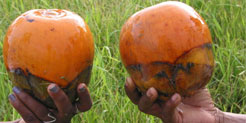African Plants
A Photo Guide

What are you looking for?
Help & User's Guide
The database contains photographs of African plants, presently with several focus regions in the savanna areas of West Africa, Nigerian-Cameroonian highlands, Congo, Tanzania and Malawi and the fynbos and grassland biome of South Africa.
-
You can search for scientific or vernacular names (or parts thereof, no wildcard necessary) via free text (in: “What are you looking for”)
-
You can browse through a taxonomic hierarchy starting with family names.
-
You can select several morphological characters and will get a result list of species we have encoded to have these characters.
The search is filtered according to the chosen character states. Chosen character states for the same character are combined with a logical “OR”, returning a list of plants with any of the chosen character states (flowers, e.g., may be red OR yellow).
Different characters, however, are combined with a logical “AND”, returning a list of plants, where the character states fit the selections for every character (e.g., only plants, with red flowers AND entire leaf margins).
Please note that the informations for character coding are taken from the literature and that not all of these characters will be visible on the photographs.
The photo guide is an aid to identification but cannot substitute an identification key. Definition of characters is rough and includes only easily visible or accessible features.
If you want to link to our site using a URL with taxon names, you can construct the URL following this example: http://www.africanplants.senckenberg.de/search.php?q=Adansonia+digitata
Help us to identify!
Some photographs of plants are not identified to species. You find them via searching for the epithet “indet.”. If you have suggestions, please let us know.
Contribute!
We welcome quality plant photos from Africa, especially documenting species previously not documented, or documenting missing details of a species. With the photos, we need some additional information on locality, which can be supplied in tabular form or directly in the EXIF/IPTC metatags, e.g. by using geosetter or comparable tools. A nice short guide for plant photos useful in species identification has been prepared by Matt Walters (Univ. Canterbury, NZ) and can be downloaded here.
Standards
Nomenclature: Use of species and family names generally follows the African Plant Database (APD).
Geography: Use of plants occurrences in geographical regions generally follows the TDWG World Geographical Scheme for recording plant distributions, ed. 2.
Language abbreviations: Use of abbreviations generally follows language codes after ISO 639-1.